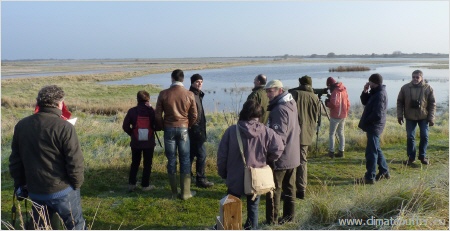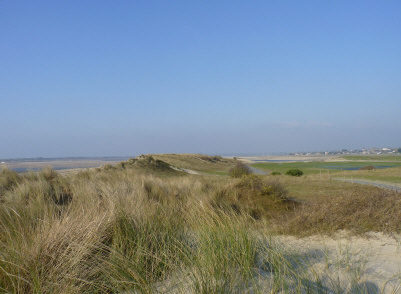Normandy Coast
Purpose of the Visit
The study visit in Normandy took place between 30th of January and 2nd of February 2012. The group learned about the impacts of climate change on the management of coastal areas. That included the issues "Management of the coastal sites facing to erosion, submersion and accretion", "Monitoring of the impacts on biodiversity, uses and land planning" and "Development of international projects on these stakes (BRANCH, LiCCo)".

The Conservatoire du Littoral owns 12.276 ha of lands in Normandy. These sites are managed by 4 different organizations:
- SyMEL (Syndicat Mixte des Espaces Littoraux de la Manche) in the department of Manche,
- SMCLEN (Syndicat Mixte Calvados Littoral des Espaces Naturels) in the department of Calvados,
- Conseil Général in the department of Seine-Maritime,
- Conseil Général in the department of Eure.

The Bay of Veys
(Photo: Celine Damery, CdL)
The LiCCo Project and the BRANCH Program
The project LiCCo (Living with a changing Coast) emerged in relation to expectations and needs of a large number of actors in the English Channel / North Sea. Indeed, the Channel area is now facing a common problem: how to adapt to coastal management in the medium and long term to better anticipate and accompany these changes with local stakeholders?
Also, the program INTERREG BRANCH (Biodiversity Requires Adaptations in Northwest Europe under a CHanging climate), from 2003 to 2007, has brought together many actors on coastal climate change issues and their impact on biodiversity. To extend the expertise of this program to other issues (including communication component), other study sites, and at the request of the main partners of BRANCH, the Conservatoire du littoral has embarked on the project Licco, in connection with the english Environment Agency.
The LiCCo project aims to raise awareness about predicted impacts of coastal change, which is a major challenge for coastal communities. The project results will be communicated to an audience as wide as possible on both sides of the Channel, and to other European programs, to any structure which may have to invest in a strategic adaptation to the effects of climate change in the medium to long term.
The European Partnership is Franco-British via the Environment Agency (English Governmental agency). The Environment Agency provides the portage of this project, the Normandy Delegation and the Syndicat Mixte du Littoral Normand (SMLN) ensure coordination of the project in France concerning the scientific aspects, conducting meetings on the sites and relationships with institutional partners.
Scientific partners : University of Caen, CERReV (Centre d’Etude et de Recherche sur les Risques et les Vulnérabilités), SyMEL (Syndicat Mixte des Espaces Littoraux de la Manche), GEMEL (Groupe d’Etudes sur les Milieux Estuariens et Littoraux), CSLN (Cellule de Suivi Littoral Normand), CBNBl (Conservatoire Botanique National de Bailleul).
Institutional partners : the Water Agency for Seine-Normandy, the Conseil régional of Haute-Normandie, the Conseil régional of Basse-Normandie.
Five Sites
Five sites were selected in Lower and Upper Normandy, as a "study sites" for the project. Their main interest lies in the fact that they all represent a type of coast, in terms of coastal geomorphology, biodiversity, governance and uses, which are also found on the lands of the Conservatoire. During the meeting, we will visit three of them:
- The Bay of Veys, already studied in the program BRANCH, is a territory at the intersection of multiple challenges. The estuary (aera with a high risk to marine submersion) risks to lose land to the sea and, with the question of the future of its biodiversity.
- The coastal marshes of the Val de Saire are representative of many sites of the Conservatoire. The risk of marine submersion is pregnant.
- The Regnéville haven is emblematic of the issues of the west coast havens of the Cotentin. The concept of Integrated Coastal Zone there makes sense.
Relevance of the Sites for the Project Issues
After having been involved in an INTERREG project concerning the impacts of climate change on biodiversity (BRANCH), the Normandy Delegation of the Conservatoire is now coordinating a project which aims to raise awareness about predicted impacts of coastal change, which is a major challenge for coastal communities: LiCCO Living with a Changing Coast. Five sites have been selected to be pilot for the LiCCO project, and, through this Leonardo meeting, the participants.
That’s why this meeting was a good opportunity to discover the actions of the Conservatoire du littoral and its partners, the way of its sites are managed, and the integration of the “climate change” factor in the daily and long-term management.
Impressions of the study visit at the Normandy
 |
 |
|
 |
||
 |
||
 |
||
 |
||
 |
||
 |
||
 |
The Leonardo group at the Normandy coastline (Photos: Celine Damery, CdL) |
The project started in 2010 and was finished in 2012.